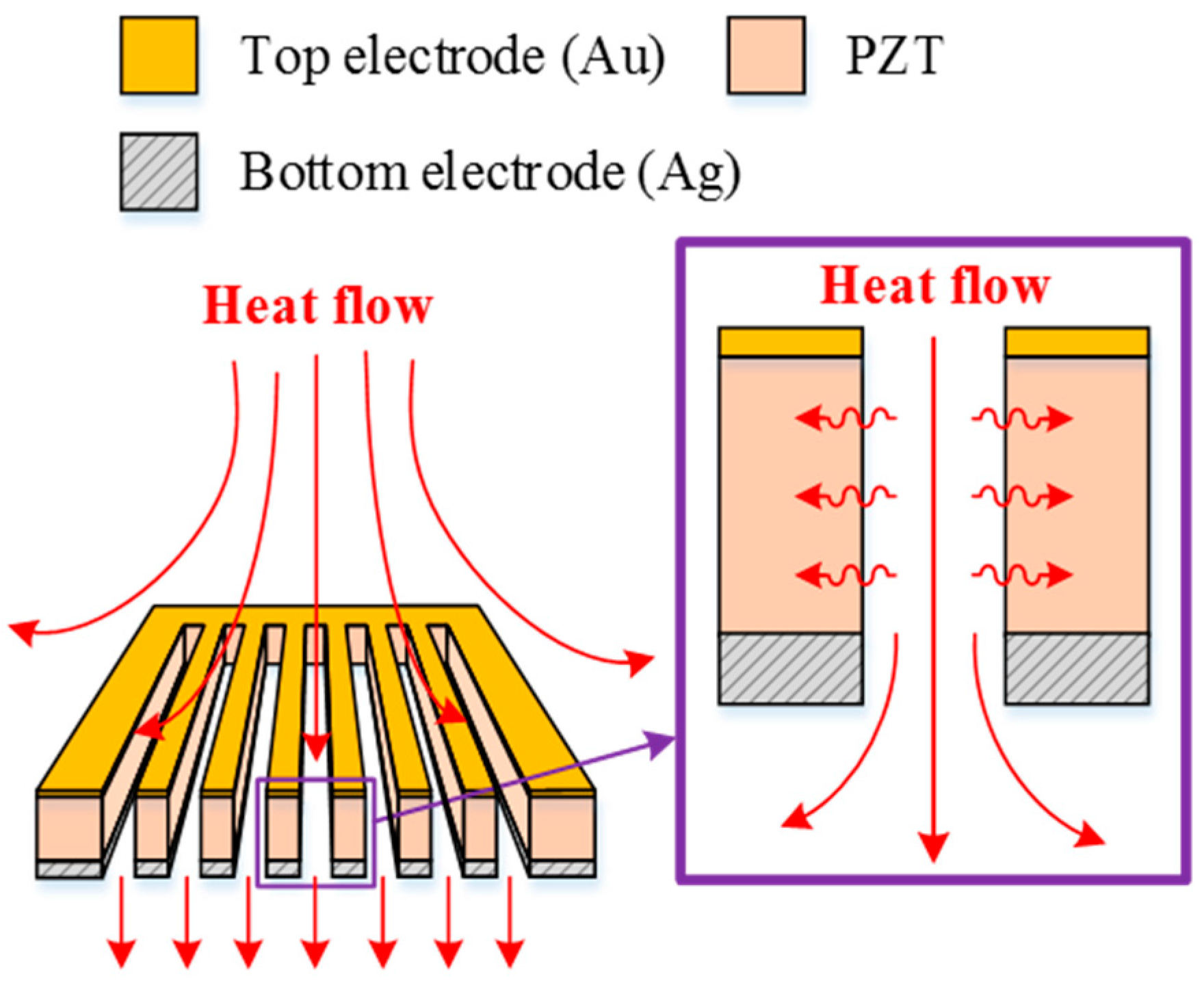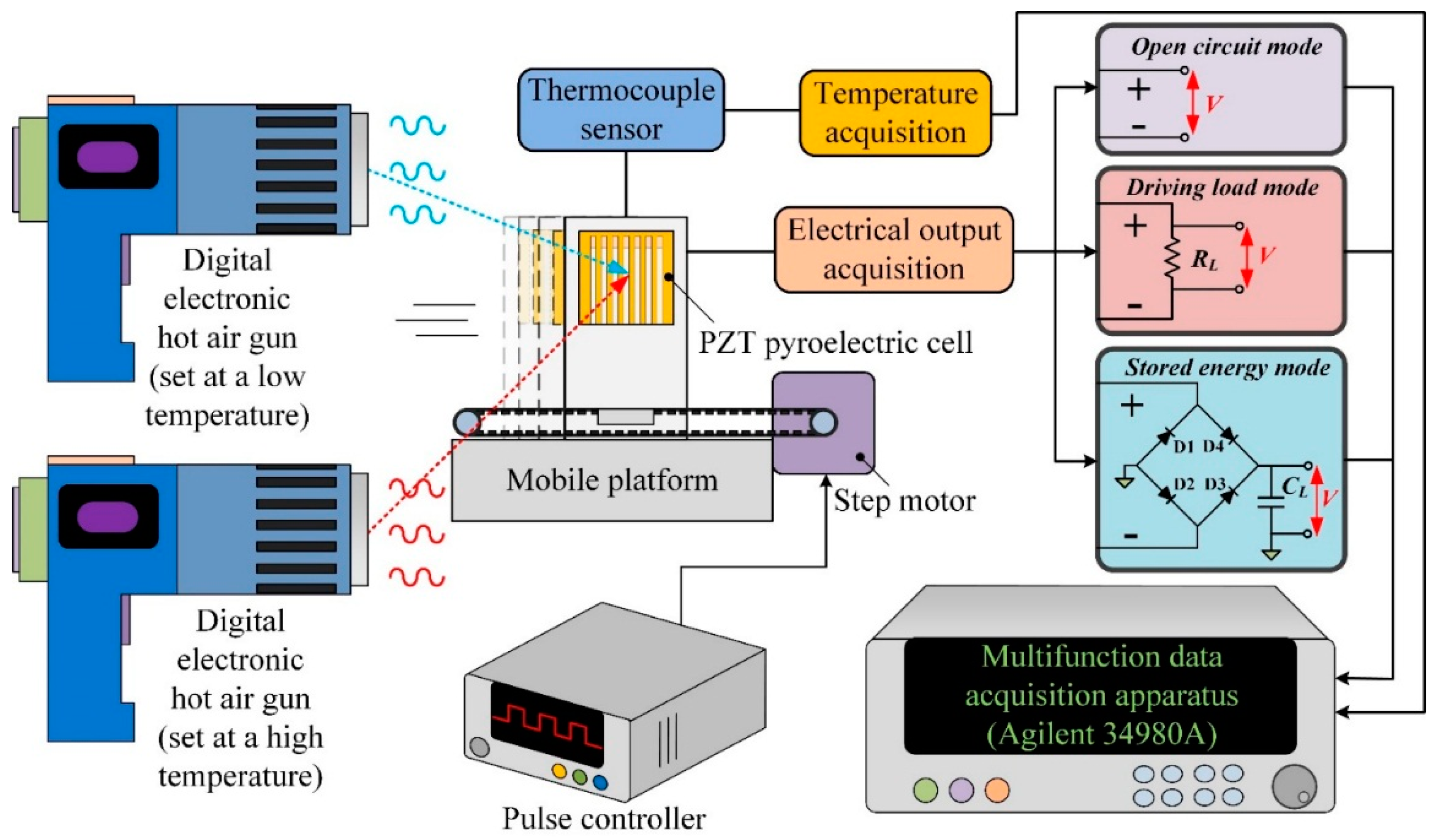A Strip Cell in Pyroelectric Devices
Abstract
:1. Introduction
2. Materials and Methods
2.1. Design and Simulation for Strip PZT Pyroelectric Cells
2.2. Fabrication and Measurement for Strip PZT Pyroelectric Cells
3. Results and Discussion
4. Conclusions
Acknowledgments
Author Contributions
Conflicts of Interest
References
- Cuadras, A.; Gasulla, M.; Ferrari, V. Thermal energy harvesting through pyroelectricity. Sens. Actuators A Phys. 2010, 158, 132–139. [Google Scholar] [CrossRef]
- Mane, P.; Xie, J.; Leang, K.K.; Mossi, K. Cyclic energy harvesting from pyroelectric materials. IEEE Trans. Ultrason. Ferroelectr. Freq. Control 2011, 58, 10–17. [Google Scholar] [CrossRef] [PubMed]
- Nguyen, H.; Navid, A.; Pilon, L. Pyroelectric energy converter using co-polymer P (VDF-TrFE) and Olsen cycle for waste heat energy harvesting. Appl. Therm. Eng. 2010, 30, 2127–2137. [Google Scholar] [CrossRef]
- Lee, F.Y.; Navid, A.; Pilon, L. Pyroelectric waste heat energy harvesting using heat conduction. Appl. Therm. Eng. 2012, 37, 30–37. [Google Scholar] [CrossRef]
- Sharma, M.; Chauhan, A.; Vaish, R.; Chauhan, V.S. Pyroelectric materials for solar energy harvesting: A comparative study. Smart Mater. Struct. 2015, 24. [Google Scholar] [CrossRef]
- Sebald, G.; Lefeuvre, E.; Guyornar, D. Pyroelectric energy conversion: Optimization principles. IEEE Trans. Ultrason. Ferroelect. Freq. Control 2008, 55, 538–551. [Google Scholar] [CrossRef] [PubMed]
- Whatmore, R.W. Pyroelectric devices and materials. Rep. Prog. Phys. 1986, 49, 1335–1386. [Google Scholar] [CrossRef]
- Hsiao, C.C.; Ciou, J.C.; Siao, A.S.; Lee, C.Y. Temperature field analysis for PZT pyroelectric cells for thermal energy harvesting. Sensors 2011, 11, 10458–10473. [Google Scholar] [CrossRef] [PubMed]
- Hsiao, C.C.; Siao, A.S.; Ciou, J.C. Improvement of pyroelectric cells for thermal energy harvesting. Sensors 2012, 12, 534–548. [Google Scholar] [CrossRef] [PubMed]
- Hsiao, C.C.; Siao, A.S. Improving pyroelectric energy harvesting using a sandblast etching technique. Sensors 2013, 13, 12113–12131. [Google Scholar] [CrossRef] [PubMed]
- Hsiao, C.C.; Jhang, J.W.; Siao, A.S. Study on pyroelectric harvesters integrating solar radiation with wind power. Energies 2015, 8, 7465–7477. [Google Scholar] [CrossRef]
- Siao, A.S.; Chao, C.K.; Hsiao, C.C. Study on pyroelectric harvesters with various geometry. Sensors 2015, 15, 19633–19648. [Google Scholar] [CrossRef] [PubMed]
- Cuadras, A.; Ovejas, V.J. Determination of a System’s Entropy Using Pyroelectric Sensors. IEEE Sens. J. 2015, 15, 6890–6897. [Google Scholar] [CrossRef]
- Norkus, V.; Schulze, A.; Querner, Y.; Gerlach, G. Thermal effects to enhance the response of pyroelectric infrared detectors. Proced. Eng. 2010, 5, 944–947. [Google Scholar] [CrossRef]
- Zhang, Q.; Agbossou, A.; Feng, Z.; Cosnier, M. Solar micro-energy harvesting with pyroelectric effect and wind flow. Sens. Actuators A Phys. 2011, 168, 335–342. [Google Scholar] [CrossRef]
- Bowen, C.R.; Taylor, J.; LeBoulbar, E.; Zabek, D.; Chauhan, A.; Vaish, R. Pyroelectric materials and devices for energy harvesting applications. Energy Environ. Sci. 2014, 7, 3836–3856. [Google Scholar] [CrossRef]














| Item | Data |
|---|---|
| Size (mm × mm) | 9 × 9 |
| Thickness (μm) | 400 |
| Area (mm2) | 81 |
| Relative dielectric constant (ε33T/ε0) | 2100 |
| Density (g/cm3) | 7.9 |
| Poling field (V/μm) | 3.5 |
| Pyroelectric coefficient (10−4 C·m−2·K−1) | 6.97 |
| Material | Density (g/cm3) | Thermal Conductivity (W/(m·K)) | Specific Heat (J/(g·K)) |
|---|---|---|---|
| PZT sheet | 7.9 | 2.1 | 0.36 |
| Electrode(Au) | 19.3 | 317 | 0.129 |
| Electrode(Ag) | 10.49 | 429 | 0.24 |
| Air | Eq1(Tabs) | Eq2(Tabs) | Eq3(Tabs) |
| Eq1(Tabs) = 101.325×103 × 0.02897/8.314/Tabs | |||
| Eq2(Tabs) = 0.00227583562 + 1.15480022 × 10−4 × Tabs − 7.90252856×10−8 × Tabs2 + 4.11702505 × 10−11 × Tabs3 − 7.43864331 × 10−15 × Tabs4 | |||
| Eq3(Tabs) = 1.04763657 − 3.72589265 × 10−4 × Tabs + 9.45304214 × 10−7 × Tabs2 − 6.02409443 × 10−10 × Tabs3 + 1.2858961 × 10−13 × Tabs4 | |||
| Item | Type A | Type B | Type C | Type D |
|---|---|---|---|---|
| Electrode area (mm2) | 81 | 81 | 44.5 | 44.5 |
| Capacitance, Cp (nF) | 4.3 | 6.4 | 3.0 | 2.7 |
| Resistance, Rp (MΩ) | 2.0 | 1.3 | 2.6 | 3.1 |
© 2016 by the authors; licensee MDPI, Basel, Switzerland. This article is an open access article distributed under the terms and conditions of the Creative Commons by Attribution (CC-BY) license (http://creativecommons.org/licenses/by/4.0/).
Share and Cite
Siao, A.-S.; Chao, C.-K.; Hsiao, C.-C. A Strip Cell in Pyroelectric Devices. Sensors 2016, 16, 375. https://doi.org/10.3390/s16030375
Siao A-S, Chao C-K, Hsiao C-C. A Strip Cell in Pyroelectric Devices. Sensors. 2016; 16(3):375. https://doi.org/10.3390/s16030375
Chicago/Turabian StyleSiao, An-Shen, Ching-Kong Chao, and Chun-Ching Hsiao. 2016. "A Strip Cell in Pyroelectric Devices" Sensors 16, no. 3: 375. https://doi.org/10.3390/s16030375
APA StyleSiao, A.-S., Chao, C.-K., & Hsiao, C.-C. (2016). A Strip Cell in Pyroelectric Devices. Sensors, 16(3), 375. https://doi.org/10.3390/s16030375






